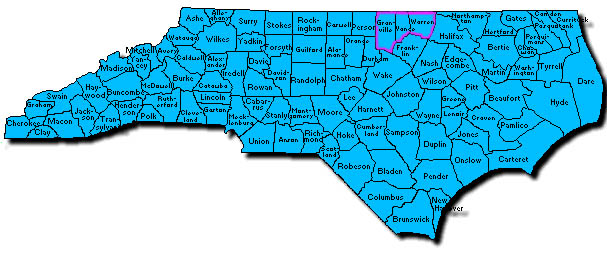This resource was developed as part of the Migration and the American South project.

Henderson, NC Train Depot (circa 1930s)
Courtesy of the North Carolina Collection, Univ. of N.C. at Chapel Hill Library
Migrations make history; the westward trek of the Mongols hastened the decline and collapse of the Roman Empire, and, much later, the western migration of Europeans to the so-called New World resulted in the destruction of countless Native American cultures. But mass migrations are not only about destruction and conquest; migration offers hope to migrants who are fleeing hunger, persecution, and a lack of opportunity. Migrants bring with them their own culture to their new home and the resulting blending of cultures can result in a new culture that is both productive and perhaps even richer than the old cultures from whence it sprung. Migration can act as a relief valve for regions with too many people and not enough land and resources and as a powerful incentive to poor regions to modernize or lose some of their most productive citizens.
The “Push” and “Pull” of Migration
When historians think about what causes migration, they think of “push” and “pull” factors. Something pushes people out of one place–a drought or perhaps an invasion–and something “pulls” them to another place–often available land or jobs. The migration might be a short distance–from the countryside to nearby cities–or great distances–across continents or oceans. Migrations can thus be internal–within a country–or external–between countries. It is easier to track and document an “external” migration because nations have historically taken a deep interest in people who cross national borders. Paperwork is filed, and migrants, particularly immigrants, are often carefully counted and scrutinized. Also, there is often more public awareness of immigrants because of language and cultural differences. But internal migrations, although more difficult to track, can be just as important.
At what point can we say a migration is occurring or has occurred? Migrations are a social phenomena–they involve groups of people. Groups–families, neighbors, even entire villages–may migrate or people may migrate “serially”–that is individuals and small groups may move, and they in turn are followed by other individuals and small groups from the same area who move to the same new location. In fact, part of the “pull” effect of migration is the influence migrants have on friends and relatives back home to join them. Migrations typically involve large numbers of people, and migrations typically last years if not decades.
Migration and the American South
The South is a region that stretches from Maryland in the Midatlantic area to Texas in the West and Arkansas and Kentucky in the North. It is an area of the United States that was originally settled thousands of years ago by migrants who originally came from Asia. Later, Europeans–English, Scots-Irish and Germans primarily–and people from west and central Africa settled the along the east coast. By the mid-1700s settlers were crossing the Appalachian mountains into what is today Tennessee. During the early decades of the 1800s, a substantial number of migrants began streaming out of the settled Southern states and moved to the”old” Southwest–Alabama, Mississippi, and ultimately to Texas. The less fecund soils and limited supply of land pushed them out of the coastal states, and the rich cotton lands of the Southwest pulled them westward. North Carolina alone lost hundreds of thousands of residents–a third or more of its residents– to this westward migration.

The United States and the South
In the early twentieth century another great migration of people poured out of the South. This migration reached its peak in the 1940s and 50s. Millions of Southerners left the region and settled in the cities and towns of the Midwest, Northeast, and to a lesser extent the West. African Americans made up a large percentage of this migration and continued to leave the region in great numbers well into the 1960s. The white migration had slowed considerably by the 1960s and significant numbers of whites were actually entering the region by then. There was also an internal migration within the South with large numbers of people leaving rural areas and migrating to the small towns and cities of the region. Although reliable figures are simply not available on this migration, probably the majority of white migrants were involved in this intra-regional migration.
What set people in motion in the South either as migrants out of the region or migrants within the region? The transformation of agriculture was a major “push” factor. People had been leaving farming for decades by the 1930s because for many farming was a sure route to poverty. Too many families pressed on on a limited amount of land; the typical farm shrank in size decade by decade after the Civil War, and the typical farmer by the 1930s was not a landowner but a tenant farmer or sharecropper who tended someone else’s land and could never seem to climb out of debt. To make matters worse, a rural depression had afflicted agriculture since the early 1920s and only worsened with the onset of the Great Depression in the 1930s. Declining agricultural prices year after year for over a decade thus drove even more sharecroppers to the cities and towns in search of better paying employment. (See The Agrarian South for a brief account of the rise and fall of sharecropping). Ironically, the federal government unwittingly encouraged this movement out of the countryside. Federal programs established by President Franklin Roosevelt’s “New Deal” during the 1930s provided farmers with cash incentives to take less productive land out of cultivation, a policy that may have stabilized agriculture but also encouraged landlords to send even more of their tenants packing. Further, farmers often used this new source of income to purchase tractors and other farm machinery. The more farmers mechanized, the less labor they needed and so even more people left the land.
African American sharecroppers were evicted from the land in greater numbers than whites because of the pervasive racial discrimination at the time and thus made up a larger portion of the migrants from the rural areas. Discrimination itself was a factor that drove many African Americans from the region. “Jim Crow” segregation was the law and custom of the region, and many African Americans migrated to escape the indignities and harassment that were part and parcel of this system of separatism. (See Race in the South for a discussion of Jim Crow.)
Jobs and the possibility of a higher standard of living “pulled” people to the cities and towns of the South and northward. Industry–primarily textiles and some tobacco, furniture, and steel manufacture–began appearing in the South after the Civil War, and this industrial growth was concentrated in the Piedmont region stretching from Richmond, Virginia to Birmingham, Alabama. By the 1920s this swath of territory was the textile capitol of the world. People hoping to escape rural poverty poured into the textile towns of the South—towns such as Greensboro, NC and Spartanburg, SC and Henderson, NC. However, the textile mills of the South would not hire blacks for anything but the most menial of jobs, a practice that would not significantly change until the late 1960s. The kinds of jobs blacks could get in the cities and towns of the South were primarily poorly paying jobs and more jobs were available for women (housekeeper and the like) than for men. Further, in many respects “Jim Crow” segregation was even harsher in the towns than it had been in the countryside. For blacks the North offered the best chance for job opportunities and an escape from “Jim Crow.” Many whites too would head north, but proportionally not in as great a number as with black Southerners.
By the 1960s the Southern economy began to change and modernize, and by the 1980s much of the region was in the midst of an economic boom. (See The Agrarian South for a more detailed discussion of this modernization.) Factory owners fled the high-wage North (and its unions) and relocated in the South, local business in cities like Atlanta and Charlotte began to take off, and tourism expanded northward from Florida and became a major industry throughout the region. At the same time, the North and Midwest experienced economic decline with factories closing by the score. A swath of the most industrialized area of the North was now nicknamed “the Rust Belt.” The economic transformation of the South coupled with the impact of the Civil Rights movement–it destroyed “Jim Crow” in the region and reduced the level of racial discrimination–exerted a “pull” on people from economically troubled regions.
Government programs and subsidies also made the region more attractive to immigrants and migration out of the region less attractive. A stream of federal money flowed into the South to support military bases, public school programs, welfare programs, and health services. Billions in federal and state tax revenues were spent on the construction of highways that now tie rural areas to urban and suburban areas and diminish rural isolation. All of the programs and services that were created by federal and state governments were designed to help people, but they also generated hundreds of thousands of new, reasonably well-paid government jobs in the social services offices, public schools, community colleges, and expanding hospitals. And so the number of people leaving the region dwindled, and a substantial migration into the South commenced and is still going on. Millions have moved into a region that once “exported” millions.
This “new” South of booming industry, growing towns and suburban areas filling with new arrivals is not the complete picture of the region. Certainly areas like Atlanta, the Research Triangle Park (situated between Raleigh and Durham, NC), and Austin, Texas are part of this boom. Schools can’t be built fast enough in these areas, highways are crowded to capacity soon after they are built or expanded, and house prices average well over $100,000. But many areas of the South–much of eastern North Carolina, and the Appalachian mountain region, and the Mississippi Delta for example–are not booming in any sense of the term. In this “other South,” out-migration may have slowed or even reversed, but often the best and brightest of the younger generation are still leaving, and many of those who come in are retirees, many of whom left the region when they were young and are now returning. Poverty rates are high, illiteracy is still a major problem, and the booming industries and businesses flocking to the “go go” areas generally aren’t interested in coming to this “other South.”
The “other South” has been since the 1960s and still is a national, regional, and state-level political priority. Most Southern states legislatures have passed a variety of laws designed to provide tax incentives and various other subsidies to companies to locate in the poorer regions. Beginning in the 1960s, many towns and counties established economic development offices to search for industry. Many began to provide local incentives such as linking proposed industrial sites to water and sewer lines and building industrial speculative buildings that are sold or rented to new industries at break-even prices. The federal government began in the 1960s to offer a variety of programs to poor communities designed to encourage economic growth. New water and sewer lines were often built with federal tax dollars and a variety of federal agencies funneled grant money into mental health agencies, hospitals, colleges and public schools in poor areas. In the 1960s the federal government initiated a “Model Towns” program that attempted to build planned communities in poorer regions. These communities were intended to act as catalysts of economic development and draw additional public and private investments to the area–a sort of “snowball effect.” All of these programs have had some impact, but generally businesses are looking for a host of characteristics–trained workers and good schools for example– that poor areas simply do not possess. As a result many poor areas of the South continue to be poor, although the programs and services and payments do appear to have halted the substantial out-migration of earlier decades.
Vance, Granville, and Warren Counties
Vance, Granville, and Warren Counties are the three North Carolina counties that are the focus of this case study. They are located along the Virginia border in the Piedmont region of the state. They are located north of Wake County (the home county of Raleigh). Interstate Highway 85 (built in the 1970s) and Highway 1 link all three countries with Raleigh and Durham (in Durham County) to the south and Richmond, Virginia to the north. It takes people living in Granville, Warren, and Vance 30 minutes to slightly over an hour to drive to Raleigh or Durham or the Research Triangle Park. Henderson is the largest town in the region with roughly 15,000 residents; the other major towns are Oxford (Granville) and Warrenton (Warren) both of which have populations of under 10,000. The region’s economy was dominated by agriculture until relatively recently, and tobacco was and still is the major cash crop. For many decades Henderson has been a regional retail center and the place where many area farmers marketed their tobacco crop. A large textile mill was built in Henderson in the 1890s–the Henderson Cotton Mill–and by the eve of World War I three additional mills were built, all owned by the same company (called Harriet & Henderson Yarns until it closed in 2003). For much of the twentieth century Henderson was the industrial center in the region and provided textile mill jobs to several thousand people.
Just as in other parts of the South, the local economy of this region began to change in the 1930s, and a major migration of people out of the countryside and smaller towns commenced that would last until the late 1960s. The same factors discussed earlier–the effects of the Great Depression, the decline of agriculture, and the limited availability of other economic opportunities especially for African Americans–led to this migration.

The economic fortunes of the region began improving by the 1960s in part as a result of large infusions of state and federal funds into the area. A portion of a U.S. army facility in southern Granville County–Camp Butner–was turned over to the state of North Carolina and two facilities for developmentally challenged people and people suffering from mental illnesses were created. These facilities–John Umstead Hospital and Murdoch Center–today employ thousands of people. In the 1970s the Bureau of Prisons of the U.S. government constructed a correctional facility in the Butner area; today there are three such facilities that employ well over one thousand people (Federal Correctional Complex pictured at right). As with the other parts of the South, Vance, Granville, and Warren counties became the beneficiaries of millions of dollars of federal aid. Funds for parks, water lines, sewers, low income housing, special programs in the public schools, expanded welfare payments, and medical services for the poor and the elderly poured into the counties. One of the “model towns”–Soul City–was constructed in Warren County in the late 1960s with millions in federal aid that paid for “infrastructure”—a water system, sewers, roads, recreational facilities, and shell buildings to house health facilities, local government agencies, and industrial tenets.
During the 1970s a concerted industrial recruitment effort by local economic developers, particularly in Vance and Granville counties, paid off and today a variety of industries–a china manufacturing plant, a cosmetics factory,a dog food company, and an electronics plant to name a few–are located in Vance and Granville counties (Warren still has relatively little industry). Special tax breaks and other benefits, the low average wages paid to area workers, the limited presence of unions, and the establishment of a local community college specializing in job training all made the area attractive to industries interested in building plants or relocating. The completion of I-85 in the 1970s also made the region more attractive to industry and made commuting into or out of the area easier. Certainly Henderson was able to hold on to its role as the regional retail center in part because I-85 went right through it. A large man-made lake built along the Virginia border by the U.S. Army Corps of Engineers–Kerr Lake–provided a huge supply of water and new recreational opportunities.
The out-migration slowed and then halted, and the region began to experience a small in-migration. These migrants–retirees, former residents of the area returning home, a smattering of professionals employed by area industries, and a growing number of immigrants originally from Central America–still constitute a relatively small percentage of the area population.
Despite significant economic and demographic changes, the region is still more a part of the “other South” than a part of the booming South of the Research Triangle Park or Atlanta or Charlotte. But this too may be temporary; poverty rates have declined and the level of new investments in the local economy in recent years has obviously risen as new franchise restaurants, office buildings, and shopping malls seem sprout up from the red clay soil on a regular basis, at least in Vance and Granville counties. The key to the area’s economic fate is its location; it is on the edge of one of the most prosperous regions in the United States. As suitable land for development becomes scarce and housing more expensive in Raleigh or the Research Triangle, developers will look further and further afield for opportunities. Indeed, the suburban developments, shopping malls, and office parks of Raleigh, Durham, and the Research Triangle are steadily inching northward toward Vance and Granville counties.

North Carolina
Other Online Sources
The History net, an online history publication, has a fine essay, a bibliography, and study guides on the movement of African Americans “From the Rural South to the Urban North.” For those desiring more background information than the essay above provides, here’s the place to start.
Go to: https://www.umbc.edu/che/tahlessons/lessondisplay.php?lesson=56
The North by South web site, constructed by two Kenyon College professors and their students, is a good, interesting examination of the migration of African Americans from Charleston, South Carolina to Harlem; from the Mississippi Delta to Chicago; and from Birmingham, Alabama, to Pittsburgh and Cleveland.
Go to: https://northbysouth.kenyon.edu/
Southern Culture is a Web course offered by Vance-Granville Community College. It has an online text with a number of links to other sites, and it provides useful (and fairly short) discussions of several key issues touched on in this essay. See in particular the unit on “The Agrarian South” for a discussion of the economic transformation of the South since the Civil War (in the second half of the unit) and Race in the South for a discussion of the birth, life, and death of Jim Crow segregation. The course also has a good bibliography on Southern history and culture (see the course syllabus).
Go to: https://www.cap-press.com/pdf/1517.pdf
The African American Mosaic: A Library of Congress Resource Guide for the Study of Black History and Culture displays some of the maps and photographs in the Library of Congress collection that document the migration of African Americans from the South to the North.
Go to: https://lcweb.loc.gov/exhibits/african/afam008.html


